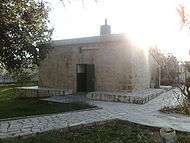Mahis
| Mahis مدينة ماحص | |
|---|---|
| Town | |
|
Late winter in Mahis | |
 Mahis Location in Jordan | |
| Coordinates: 31°59′N 35°46′E / 31.983°N 35.767°E | |
| Country |
|
| Governorate | Balqa Governorate |
| Founded | 350 B.C. |
| Elevation | 2,600 ft (800 m) |
| Population (2005) | |
| • Total | 14,000 |
| Time zone | UTC+2 (UTC+2) |
| • Summer (DST) | UTC+3 (UTC+3) |

Mahis (Arabic: ماحص) is a Jordanian town located in the Balqa Governorate north west from the governorate's capital city Balqa, and 10 km west of Amman. Its population exceeds 14,000. Most of the population of Mahis descends from the Al-Abbadi tribe [1] (Arabic: العبادي). The mountainous town is located at over 800 metres,[2] with panoramic views on the Jordanian valley, West Bank with Jerusalem's walls visible on the horizon. Mahis is known for its orchards and its numerous water fountains and springs, notably the Fountain of Mahis.
History

Mahis is believed to emerged during the Roman period, when it bordered Jewish Perea and the territory of Philadelphia - Amman of the Decapolis, and in the Byzantine period between the territory of the diocesis of Gadara - Salt and Philadelphia.[3] The name comes from the Arabic word (Arabic: محص) meaning to check out and examine due to its status as a border check point.
Religious importance
In Mahis there is a shrine of Khidr, a single room surrounded by a small garden with a green flag on top.[4][5] Near Mahies (2 km West of Mahis) in an area called Wadi Shoaib, is the grave of prophet Shoaib, or Jethro in the biblical tradition.[6]
Economy
Mahis is based on an agrarian economy, including wheat, barley, and tobacco as well as pomegranates, grapes and olives. The importance of agriculture is decreasing, though figs and olives are still a primary source of income. The area also produces natural goods such as Kaolin which is then produced in the neighbouring city Fuhais.[7] The southern part of the Mahis territory called Almeda (Arabic: الميدة) also attracts tourism due to its forested mountains and location near the Dead Sea/West Bank as well as Amman. Mahis also focuses on education and is well known for its higher education academic disciplines.
Demographics
The population is generally Arabs, mainly descended from the Al-Abbadi tribe, the second largest in Jordan,[8] also referred to as the clan of Al-Jbara, including Al-Sheyab, Al-Shebly, Al-Jawaldeh and others.
References
- ↑ Bawazir.com (Arabic Online)
- ↑ Indexmundi.com Online.
- ↑ RICERCA STORICO-ARCHEOLOGICAIN GIORDANIA XXIII - 2003 (Pdf file Research by Basema Hamarneh)
- ↑ Zain-Eldin, Mustafa Bin-Hashim (Summer 2003). "Jordan: The Land of Prophets" (PDF). Islamic Tourism (7): 66–74. Retrieved 2010-12-27.
- ↑ The American Schools of Oriental Research Online
- ↑ Peterjclark.tripod.com Online.
- ↑ Jordandevnet.org Online Archived July 26, 2011, at the Wayback Machine.
- ↑ العشائر الاردنيه - بني عباد آل عبادي (in Arabic). Retrieved 2010-12-27.
External links
- Pictures of rural parts of Mahis
- mahis websites
- Prophet Shoaib “Jethro” Mosque and Tomb
- Pictures of Mahis from Travelpost.com
- Satellite pictures of Mahis
- Mahis Location on the Map and Weather
Coordinates: 31°59′N 35°46′E / 31.983°N 35.767°E
